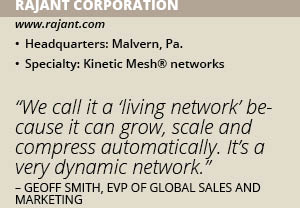Rajant Corporation
Rajant Corporation offers a groundbreaking mobile wireless mesh network and a broadband solution.
For people working in challenging and changing environments or desolate locations, communicating via a fixed network – such as cellular or Wi-Fi – can be difficult.
Fixed infrastructure networks have dead zones and are not designed for mission critical operations. People working in mining, at ports and for the oil and gas industry are among those that need reliable networks for communication to operate successfully.
Rajant Corporation, the exclusive provider of Kinetic Mesh® wireless networks, offers a groundbreaking solution for these markets.
It can deploy a highly adaptable and scalable network that leverages the power of real-time data to deliver on-demand, critical business intelligence from the field.
 “The technology that Rajant invented can link up to any infrastructure that exists, including a satellite if you’re in the middle of nowhere,” says Geoff Smith, EVP of global sales and marketing. “We call it a ‘living network’ because it can grow, scale and compress automatically. It’s a very dynamic network.”
“The technology that Rajant invented can link up to any infrastructure that exists, including a satellite if you’re in the middle of nowhere,” says Geoff Smith, EVP of global sales and marketing. “We call it a ‘living network’ because it can grow, scale and compress automatically. It’s a very dynamic network.”
Rajant Kinetic Mesh® networks are unlike any other wireless mesh network offered on the market today, providing fully mobile wireless broadband connectivity that is simple, instantaneous and fail-proof in any application.
“We’re the only company that has this type of technology,” Smith says. “There are companies that offer fixed mesh. But our kinetic mesh is truly mobile. It allows you to work in environments that are always changing.”
The living mesh solution moves and evolves with connectivity demands. Through its patented Kinetic Mesh® network, Rajant brings to life an agile and adaptable wireless mesh network and a broadband solution that thrives in today’s diverse, ubiquitously mobile environments.
Mining The Market
Rajant Corporation was founded by Robert J. Schena and Paul Hellhake shortly after the terrorist attacks upon the United States on Sept. 11, 2001. The two entrepreneurs recognized the importance of reliable communication for first responders within locations that are prone to dead zones.
Although public safety is a market for Rajant, the company also provides its solutions to the military and the mining industry and is seeing a fast-growing interest from the energy industry and ports.
“Both markets are moving very quickly for us,” Smith says. “There is a much bigger push to get away from relying on fixed static infrastructure because it can’t handle a changing environment. You need a mobile network that can move with you and provide critical communication.”
The company entered the mining industry roughly 10 years ago and ports followed shortly after that. “In a mining operation, trucks and bulldozers are repetitively moving from one place to another and ports use autonomous cranes,” Smith says. “Autonomy is a very critical application because it requires critical communication to move. If it stops, you lose productivity.”
Like ports, mining is an industry where even short periods of operational downtime can cause millions of dollars in losses. Mining operators must be able to monitor, manage and control their large fleets of high-value equipment, vehicles and personnel — wherever they travel across large areas of rugged mining terrain.
Rajant offers a BreadCrumb solution. By placing “bread crumbs” directly on vehicles, shovels and drills, mining operators can link them together as part of a mobile network — allowing for real-time information from each asset’s applications on status, efficiency and maintenance needs.
The oil and gas industry is another market that can benefit from Rajant’s Kinetic Mesh® network solutions. The company offers the industry the ability to access real-time data and analytics as part of a fully integrated view of the oil field, understanding all aspects of the assets and personnel operating within it.
Its BreadCrumb solution allows for an immediate connection to any wellhead across an oilfield and instantly access to flowmeter data, pressure sensors and other downhole pump efficiency data. This eliminates the need for a technician to visit the location each time the asset needs to be evaluated.
In the future, Rajant plans to enter other markets where it can apply its technology. “We’re taking that technology and expanding its applications,” Smith says. “Right now, we’re working around autonomous vehicles and drones.”